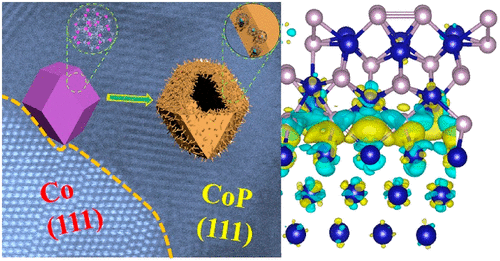Our official English website, www.x-mol.net, welcomes your
feedback! (Note: you will need to create a separate account there.)
Multiregion Janus-Featured Cobalt Phosphide-Cobalt Composite for Highly Reversible Room-Temperature Sodium-Sulfur Batteries.
ACS Nano ( IF 15.8 ) Pub Date : 2020-07-16 , DOI: 10.1021/acsnano.0c03737
Zichao Yan 1 , Yaru Liang 2 , Weibo Hua 3 , Xia-Guang Zhang 4 , Weihong Lai 1 , Zhe Hu 1 , Wanlin Wang 1 , Jian Peng 1 , Sylvio Indris 3 , Yunxiao Wang 1 , Shu-Lei Chou 1 , Huakun Liu 1 , Shi-Xue Dou 1
ACS Nano ( IF 15.8 ) Pub Date : 2020-07-16 , DOI: 10.1021/acsnano.0c03737
Zichao Yan 1 , Yaru Liang 2 , Weibo Hua 3 , Xia-Guang Zhang 4 , Weihong Lai 1 , Zhe Hu 1 , Wanlin Wang 1 , Jian Peng 1 , Sylvio Indris 3 , Yunxiao Wang 1 , Shu-Lei Chou 1 , Huakun Liu 1 , Shi-Xue Dou 1
Affiliation

|
Electrode materials with high conductivity, strong chemisorption, and catalysis toward polysulfides are recognized as key factors for metal-sulfur batteries. Nevertheless, the construction of such functional material is a challenge for room-temperature sodium-sulfur (RT-Na/S) batteries. Herein, a multiregion Janus-featured CoP-Co structure obtained via sequential carbonization–oxidation–phosphidation of heteroseed zeolitic imidazolate frameworks is introduced. The structural virtues include a heterostructure existing in a CoP-Co structure and a conductive network of N-doped porous carbon nanotube hollow cages (NCNHCs), endowing it with superior conductivity in both the short- and long-range and strong polarity toward polysulfides. Thus, the S@CoP-Co/NCNHC cathode exhibits superior electrochemical performance (448 mAh g–1 remained for 700 times cycling under 1 A g–1) and an optimized redox mechanism in polysulfides conversion. Density functional theory calculations present that the CoP-Co structure optimizes bond structure and bandwidth, whereas the pure CoP is lower than the corresponding Fermi level, which could essentially benefit the adsorptive capability and charge transfer from the CoP-Co surface to Na2Sx and therefore improve its affinity to polysulfides.
中文翻译:

用于高度可逆的室温钠硫电池的多区域Janus特色钴磷钴复合材料。
具有高电导率,强化学吸附性和对多硫化物的催化作用的电极材料被认为是金属硫电池的关键因素。然而,这种功能材料的构造对于室温钠硫(RT-Na / S)电池是一个挑战。在此,通过获得的多区域Janus特征的CoP-Co结构介绍了杂种沸石咪唑酸盐骨架的连续碳化-氧化-磷酸化。结构优点包括CoP-Co结构中存在的异质结构和N掺杂的多孔碳纳米管空心笼(NCNHC)的导电网络,使它在短距离和长距离以及对多硫化物的强极性中均具有出色的导电性。因此,在S @ COP-的Co / NCNHC阴极表现出优良的电化学性能(448毫安克-1仍然是在1 A克循环700次-1)和优化的多硫化物转化氧化还原机理。密度泛函理论计算表明,CoP-Co结构优化了键结构和带宽,而纯CoP低于相应的费米能级,这可能从吸附能力和电荷从CoP-Co表面到Na 2 S x的转移上都将大有裨益。因此提高了它对多硫化物的亲和力。
更新日期:2020-07-16
中文翻译:

用于高度可逆的室温钠硫电池的多区域Janus特色钴磷钴复合材料。
具有高电导率,强化学吸附性和对多硫化物的催化作用的电极材料被认为是金属硫电池的关键因素。然而,这种功能材料的构造对于室温钠硫(RT-Na / S)电池是一个挑战。在此,通过获得的多区域Janus特征的CoP-Co结构介绍了杂种沸石咪唑酸盐骨架的连续碳化-氧化-磷酸化。结构优点包括CoP-Co结构中存在的异质结构和N掺杂的多孔碳纳米管空心笼(NCNHC)的导电网络,使它在短距离和长距离以及对多硫化物的强极性中均具有出色的导电性。因此,在S @ COP-的Co / NCNHC阴极表现出优良的电化学性能(448毫安克-1仍然是在1 A克循环700次-1)和优化的多硫化物转化氧化还原机理。密度泛函理论计算表明,CoP-Co结构优化了键结构和带宽,而纯CoP低于相应的费米能级,这可能从吸附能力和电荷从CoP-Co表面到Na 2 S x的转移上都将大有裨益。因此提高了它对多硫化物的亲和力。































 京公网安备 11010802027423号
京公网安备 11010802027423号